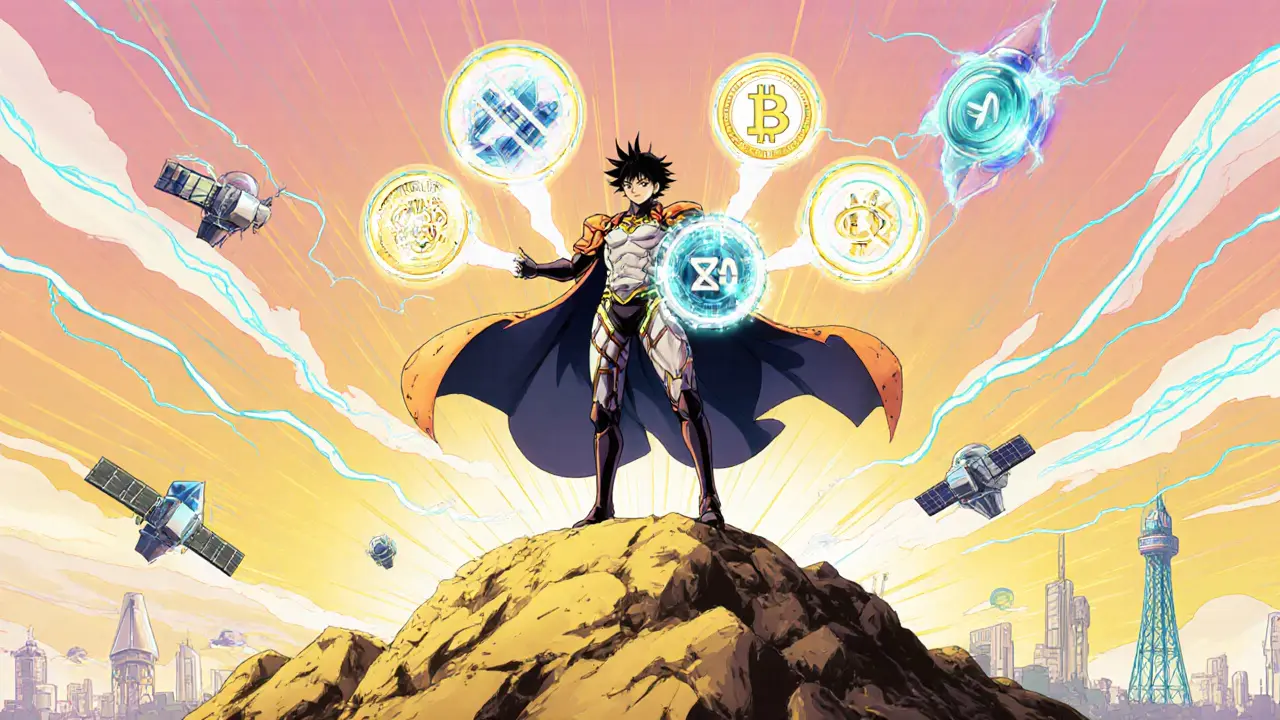Oracle Architecture Comparison Tool
Trust Model: Single provider is trusted
Security: High risk of single-point failure
Latency: Fast (few hops)
Use Cases: Simple price feeds, early-stage dApps
Trust Model: Multiple independent nodes reach consensus
Security: Resistant to tampering, but complex to coordinate
Latency: Moderate (consensus rounds)
Use Cases: DeFi indices, cross-chain bridges
Trust Model: Providers stake tokens; bad behavior slashes stake
Security: Balances security and speed
Latency: Low to moderate
Use Cases: Insurance triggers, IoT sensor data
Choose Your Oracle Architecture
When you hear the term oracle problem is a fundamental trust challenge that appears every time a blockchain smart contract needs data from the real world. In plain English, a blockchain is great at keeping a ledger consistent, but it can’t reach out to a weather API, a stock ticker, or an IoT sensor on its own. That missing bridge is what we call the oracle problem, and solving it decides whether a decentralized app can actually do anything useful beyond moving tokens.
Key Takeaways
- Blockchains are isolated by design; they need oracles to fetch or push external data.
- Oracles introduce new trust and security risks, often summarized as hotkey and operator risks.
- Different oracle architectures (centralized, decentralized, hybrid) trade off trust, speed, and cost.
- Best‑practice patterns-multiple data sources, staking, cryptographic proofs-help mitigate the oracle problem.
- Understanding these trade‑offs is essential for developers building DeFi, insurance, or supply‑chain contracts.
Why Smart Contracts Need Real‑World Data
Imagine a decentralized finance (DeFi) loan that should auto‑repay when the borrower’s salary hits a certain threshold. The contract can check the borrower’s wallet balance, but it can’t read the payroll system unless something tells it. The same goes for insurance contracts that trigger payouts after a natural disaster, or trade‑finance agreements that release funds once a shipping document is verified. In all these cases, the on‑chain code is deterministic, but the condition “salary > $5,000” or “storm severity = high” lives off‑chain.
How Oracles Work: From Request to Response
A smart contract is a piece of code stored on a blockchain that automatically enforces agreements starts by emitting a data request to an oracle a bridge that fetches, verifies, and delivers off‑chain information to the blockchain. The request hits an on‑chain oracle contract, which then signals an off‑chain oracle node. That node reaches out to the external source-say, a price feed from a cryptocurrency exchange-collects the value, optionally runs verification logic, and finally writes the result back to the original smart contract.
Because the blockchain can only accept data that arrives through a transaction, the oracle’s return is signed with a private key (the “oracle hotkey”). This signature is what the contract trusts, which leads straight into the security concerns we’ll unpack next.
Trust and Security Challenges
Blockchains pride themselves on being trustless: every node validates every transaction against the same rules. An oracle, however, is an external actor that the chain must trust. Two risk categories dominate the discussion:
- Oracle Hotkey Risk - If an attacker steals the private key that the oracle uses to sign data, they can feed any bogus value into the contract. This is especially dangerous for high‑value contracts like collateralized loans.
- Oracle Operator Risk - Even without a key compromise, the entity running the oracle could intentionally report false data to profit from the contract’s logic.
Both risks boil down to a single question: How can on‑chain code verify that off‑chain data is authentic and untampered? The answer isn’t simple, which is why many projects layer additional safeguards.

Types of Oracles and Their Trade‑offs
| Architecture | Trust Model | Security | Latency | Typical Use‑Cases |
|---|---|---|---|---|
| Centralized | Single provider is trusted | High risk of single‑point failure | Fast (few hops) | Simple price feeds, early‑stage dApps |
| Decentralized (Consensus‑Based) | Multiple independent nodes reach consensus | Resistant to tampering, but complex to coordinate | Moderate (consensus rounds) | DeFi indices, cross‑chain bridges |
| Hybrid (Staked + Reputation) | Providers stake tokens; bad behavior slashes stake | Balances security and speed | Low to moderate | Insurance triggers, IoT sensor data |
Each architecture tries to reduce the trust gap in its own way. Centralized oracles are easy to set up but give up the core blockchain promise of trustlessness. Decentralized oracles, like those used by Chainlink, crowdsource data from many nodes and apply a majority‑vote rule, which dramatically lowers the chance of a single malicious actor succeeding. Hybrid models add economic incentives-staking and slashing-to push operators toward honest behavior.
Practical Mitigation Patterns
Developers don’t have to pick a perfect oracle; they can stitch together several patterns to cover the biggest risks:
- Multi‑Source Aggregation - Pull the same data from three independent providers, then take the median value. This blunts outliers caused by a compromised source.
- Staking & Slashing - Require oracle operators to lock up a sizable amount of the native token. If the data is proven false, the stake is burned, aligning financial incentives.
- Cryptographic Proofs - Use TLS notary services or Zero‑Knowledge proofs that mathematically attest to the correctness of the data without revealing it.
- Off‑Chain Computation & Verifiers - Run heavy verification logic off‑chain, then publish a succinct proof that the on‑chain contract can quickly verify.
- Time‑Locking & Dispute Windows - Give the community a short window to challenge a data point before the contract proceeds.
When you combine these patterns, the oracle’s trust score rises dramatically, and the chances of a single point of failure plummet.
Real‑World Examples
Here are a few concrete cases where the oracle problem shows up and how teams tackled it:
- Decentralized Exchange (DEX) Pricing - A DEX needs up‑to‑date token prices. Chainlink’s decentralized oracle network supplies price feeds from dozens of exchanges, aggregates them, and stakes operators to keep the data honest.
- Weather‑Insurance Smart Contract - A crop‑insurance protocol pulls weather data from two satellite providers and a national meteorological service. It takes the median reading, and any outlier must be disputed within a 2‑hour window, otherwise it’s accepted.
- Supply‑Chain Tokenization - An IoT sensor attached to a shipping container sends temperature logs to an off‑chain server. The server signs each log with an embedded hardware TPM (Trusted Platform Module). The smart contract verifies the TPM signature before releasing payment.
Emerging Research and Future Directions
The oracle problem isn’t going away; it’s evolving. Researchers are experimenting with:
- Fully on‑chain data sources like oracle‑compatible blockchains that embed external APIs as native modules.
- Zero‑knowledge rollups that let an oracle prove “the data satisfies condition X” without revealing the raw value.
- Cross‑chain oracle frameworks that relay data between distinct networks using cryptographic bridges, reducing reliance on a single chain’s validator set.
These advances aim to preserve the deterministic nature of smart contracts while expanding the universe of data they can safely consume.
Frequently Asked Questions
What exactly is the oracle problem?
The oracle problem is the mismatch between a blockchain’s isolated, trustless environment and the need for external, real‑world data. Because smart contracts can’t fetch data on their own, they must rely on an oracle, which re‑introduces a trust component that the blockchain originally avoided.
Are centralized oracles always unsafe?
Not necessarily. For low‑value or prototype projects, a single trusted provider can be fine. Risks rise sharply as the financial stake grows, because a compromised central oracle can manipulate contract outcomes.
How does staking protect against bad oracle behavior?
Operators lock up tokens that can be burned (slashed) if they feed false data. The economic loss deters attacks, and the community can trigger slashing through an on‑chain dispute mechanism.
Can I build a completely trustless oracle?
True trustlessness is elusive because any off‑chain source must be verified somehow. The closest you can get is a decentralized, consensus‑based oracle network that combines many independent data providers and economic penalties for bad actors.
What role does Zero‑Knowledge proof play in oracle design?
Zero‑knowledge proofs let an oracle prove that a piece of data meets a condition (e.g., temperature<5°C) without revealing the raw value. This protects privacy while still giving the smart contract a verifiable trigger.

Next Steps for Developers
If you’re about to launch a smart contract that depends on off‑chain information, follow this quick checklist:
- Identify every external datum your contract needs.
- Pick at least two independent oracle providers for each datum.
- Implement a median/majority‑vote aggregation in the contract.
- Require oracle operators to stake a reasonable amount of the network token.
- Add a dispute window (e.g., 15 minutes) where anyone can challenge a reported value.
- Test the whole flow on a testnet with simulated attacks (key theft, delayed responses).
Running through these steps will dramatically reduce the chances that a single compromised oracle can ruin your users’ funds.
In short, the oracle problem is the price you pay for bringing real‑world context into blockchain logic. By understanding the trust gaps and applying proven mitigation patterns, you can build contracts that stay true to the blockchain’s promise of security while delivering genuine, data‑driven value.










Comments (18)
Stefano Benny
September 12, 2025 AT 11:28 AMHonestly, most of these oracle diagrams are just fancy marketing fluff 🤷♂️
John Kinh
September 15, 2025 AT 22:48 PMCan't believe people still debate this when the solution is staring at them – pick a decentralized feed and move on 😂
Sure, governance adds overhead, but it's not a reason to freeze innovation.
Just pick the tool that matches your risk appetite.
Mark Camden
September 19, 2025 AT 10:08 AMThe oracle problem, while often reduced to a mere data retrieval issue, fundamentally challenges the core trust assumptions of blockchain protocols.
In any decentralized ledger, every node must achieve consensus on state transitions without reliance on external actors, yet the introduction of an oracle reintroduces a privileged entity.
Consequently, developers must scrutinize the cryptographic guarantees of the oracle's signature scheme, ensuring that hotkey compromise does not cascade into systemic failure.
Moreover, the operator model demands rigorous governance frameworks that delineate responsibilities, liability, and remediation pathways.
Empirical evidence from high‑profile incidents, such as the 2020 price‑feed manipulation attacks, underscores the perils of a single point of failure.
Hence, a prudent architecture employs multi‑source aggregation, wherein at least three independent feeds are queried and a median algorithm determines the canonical value.
This statistical mitigation attenuates outlier influence, provided the feeds are sufficiently decorrelated.
Staking mechanisms further buttress security by incentivizing honest behavior through slashing penalties calibrated to the economic exposure of the contract.
Nevertheless, the design of slashing conditions must avoid over‑penalization that could deter participation, striking a balance between deterrence and accessibility.
Zero‑knowledge proofs present an emerging avenue, allowing an oracle to attest to the validity of a datapoint without revealing the raw value, thereby preserving privacy and reducing attack surface.
However, the computational overhead of succinct proofs remains non‑trivial, demanding careful gas budgeting.
In practice, a hybrid approach that couples decentralized consensus with on‑chain verification yields the most resilient solution.
Developers should also instrument dispute windows, granting the community a predefined interval to challenge anomalous data before settlement.
Finally, continuous monitoring of oracle node uptime and performance metrics is indispensable for maintaining system integrity over time.
In sum, treating the oracle as a first‑class component of the smart contract's threat model is essential for any production‑grade DeFi deployment.
MARLIN RIVERA
September 22, 2025 AT 21:28 PMWhat a waste of bandwidth writing essays when the solution is simple: use Chainlink.
Jenae Lawler
September 26, 2025 AT 08:48 AMFrom an American perspective, it is unsurprising that many of these frameworks are plagued by over‑engineered solutions that ignore pragmatic market realities.
Chad Fraser
September 29, 2025 AT 20:08 PMHey folks, don’t let the hype drown out the real potential – give these oracles a chance and you might actually build something useful! 🚀
Jayne McCann
October 3, 2025 AT 07:28 AMI think most of this is just buzz; you can get by with a simple API call.
Richard Herman
October 6, 2025 AT 18:48 PMWhile simplicity has its merits, incorporating redundancy can shield against single‑point failures without overly complicating the stack.
Parker Dixon
October 10, 2025 AT 06:08 AMExactly! 🙌 A common pattern is to fetch data from three providers, take the median, and optionally add a time‑lock for disputes. This gives you both robustness and a clear resolution path.
Don’t forget to verify the oracle’s signature against the on‑chain public key to prevent hotkey spoofing.
Bobby Ferew
October 13, 2025 AT 17:28 PMOh great, another “deep dive” that pretends to enlighten while actually just rehashing the same old oracle dogma – impressive, really.
celester Johnson
October 17, 2025 AT 04:48 AMIf we contemplate the nature of trust, we realize that any data ingress is a metaphysical concession: the blockchain surrenders its purity for utility. Thus, the oracle becomes the necessary evil, a bridge between the deterministic and the stochastic.
Prince Chaudhary
October 20, 2025 AT 16:08 PMLet’s keep the discussion constructive and focus on practical steps developers can take to mitigate risks, rather than descending into endless critique.
Evie View
October 24, 2025 AT 03:28 AMConstructive? Please, the only constructive thing here is to shut down the naive optimism that blinds newcomers.
Sidharth Praveen
October 27, 2025 AT 13:48 PMStay positive, folks – every challenge in oracle design is just another opportunity to innovate.
Sophie Sturdevant
October 31, 2025 AT 01:08 AMIndeed, leveraging multi‑source aggregation and staking slashing mechanisms will dramatically increase your security posture, so double‑down on those patterns.
Nathan Blades
November 3, 2025 AT 12:28 PMThe oracle is the heartbeats of your smart contract, pulsing external truth into the immutable ledger.
When you ignore its fragility, you gamble with the very foundation of decentralization.
Embrace redundancy, embed cryptographic verification, and your protocol will thrive.
Remember, every data point is a trust transaction – treat it with the reverence it deserves.
Layered defenses are not optional; they are the only path to sustainable on‑chain relevance.
So design with foresight, test rigorously, and let the community audit your choices.
Only then can you claim true resilience.
Somesh Nikam
November 6, 2025 AT 23:48 PMWell said! 😊 Ensure your SLAs define acceptable latency, and log every oracle round for post‑mortem analysis – that’s the hallmark of production‑grade engineering.
Jan B.
November 10, 2025 AT 11:08 AMGood points keep it simple and test often